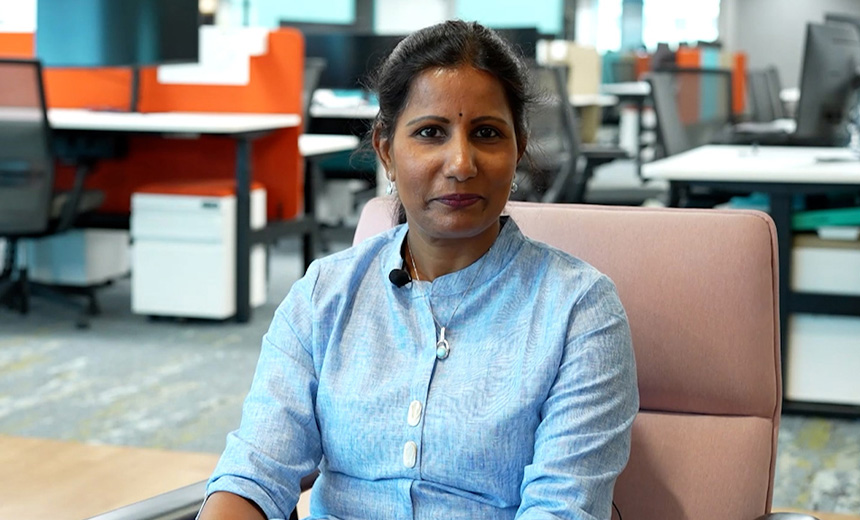Artificial Intelligence & Machine Learning
Palo Alto Networks’ Meerah Rajavel on Securing Enterprises With ‘Precision AI’
The landscape of cybersecurity can feel like navigating through a complex maze. Cybersecurity professionals are inundated with vast amounts of data from logs, endpoint detection systems, and firewalls while managing a multitude of cybersecurity tools. The pressing need is for streamlined processes and unified architectures powered by artificial intelligence.
In an insightful conversation with Information Security Media Group, Meerah Rajavel, the CIO of Palo Alto Networks based in San Francisco, shed light on the integration of AI technologies in combating today’s sophisticated cybersecurity threats. “Security is a solvable problem only if you view it through a lens of transforming complexity into clarity,” she remarked.
Rajavel oversees the global IT functions at Palo Alto Networks, spearheading a comprehensive strategy that focuses on delivering innovative solutions to diverse teams across the globe.
Precision AI: The Game Changer in Cybersecurity
Since its inception, Precision AI has marked a turnaround in tackling cybersecurity challenges. Rajavel highlighted that this advanced AI leverages machine learning and deep learning to provide exceptional accuracy. Every day, it helps block over 11.3 billion threats, with 2.3 million being new, emphasizing the necessity of deep learning capabilities in identifying these unique risks daily.
As generative AI introduces both new opportunities and challenges, Rajavel pointed out, “Cybersecurity demands 100% accuracy.” Precision AI merges the best attributes of machine learning and generative AI to enhance efficiency and deliver timely insights for security practitioners. This ground-breaking technology simplifies data analysis, providing context-specific insights that allow practitioners to manage vast data amounts with precision.
Palo Alto’s Three-Pronged AI Approach
Palo Alto Networks adopts a tri-fold approach to AI in cybersecurity, addressing three factors:
- Securing AI by Design: As clients increasingly adopt AI, ensuring its secure integration is paramount.
- Countering AI-driven Attacks: With adversaries adopting AI for their attacks, leveraging AI solutions is crucial for defense.
- Enhancing Security Practitioners’ Efforts: Simplifying complex data analyses and improving operational efficiency through AI is essential.
Rajavel noted that solutions like AI Access Security, which offers insights into AI usage within organizations, have already been successfully implemented for over 100 customers. Importantly, enterprises do not need to be highly advanced to benefit; Palo Alto’s platforms adapt to their capabilities and develop alongside their growth.
More than 10,000 models and 200 engineers dedicated to research and development highlight Palo Alto’s commitment to continuously enhance its cybersecurity capabilities. Their Cortex platform processes a staggering 7.6 petabytes of data daily, identifying key incidents from millions of events, allowing customers to hone in on significant threats efficiently.
Navigating Accountability in AI Governance
As AI systems grow more autonomous, accountability and governance become critical concerns. An interesting dialogue with a CISO from the insurance sector revealed the complexities surrounding accountability, especially when errors arise from autonomous systems. Who bears responsibility for the repercussions—technology, operational leaders, or product designers?
Rajavel asserts that today the functional heads are typically held accountable, but the rapid evolution of AI technologies means governance models must evolve to clearly define expectations and responsibilities.
The Rise of Autonomous Security Operations Centers (SOCs)
The advent of autonomous SOCs is largely driven by two pressing factors: the speed of adversarial evolution and a growing shortage of qualified cybersecurity personnel. Rajavel highlighted how their Extended Incident Management (XIM) solution, launched just two years ago, quickly became a leading segment with nearly a billion dollars in revenue, demonstrating rapid adoption among enterprises seeking immediate solutions.
Cybersecurity in the Age of AI
As AI takes center stage, Rajavel believes that cybersecurity is receiving the attention it merits. “If anything, AI has amplified security concerns more than previous technological shifts,” she observed. The swift advancement and potential risks associated with AI have prompted boardrooms to prioritize cybersecurity discussions to mitigate economic consequences, as highlighted by costly breaches in major corporations.
In a regulatory environment tightening around cyber-laws, including stringent breach reporting requirements, organizations are coming to view cybersecurity as integral to their overall strategy—beyond mere compliance.
Ultimately, as AI technologies develop, their relationship with cybersecurity will be one of mutual reinforcement rather than competition, ensuring a safe digital landscape.
Conclusion
The discussion on integrating AI into cybersecurity is ongoing, and the implications are vast. It’s clear that embracing these advanced technologies will be critical in navigating future threats. The AI Buzz Hub team is excited to see where these breakthroughs take us. Want to stay in the loop on all things AI? Subscribe to our newsletter or share this article with your fellow enthusiasts.




